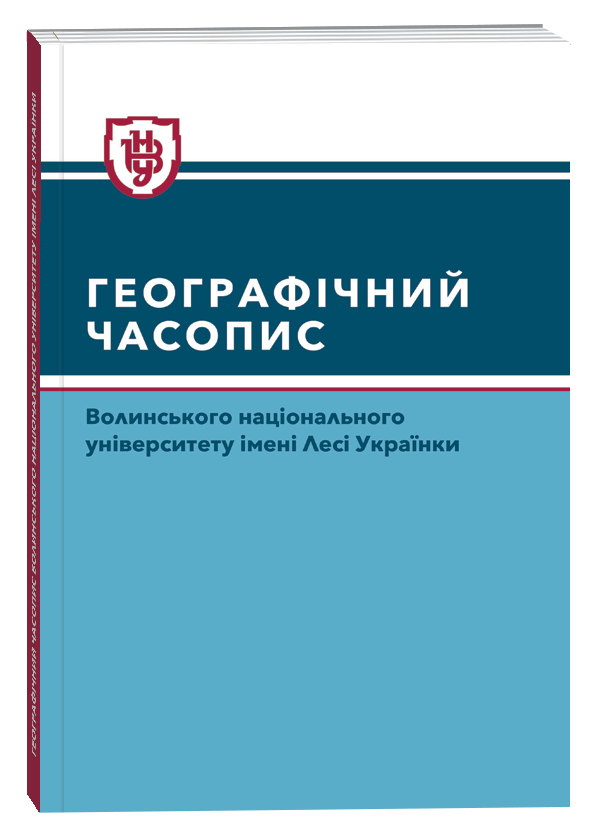HYDROGRAPHY AND WATER RESOURCES OF POLAND: STATE, USE, MANAGEMENT
DOI:
https://doi.org/10.32782/geochasvnu.2025.5.05Keywords:
hydrography, water bodies, hydrographic zoning, river, lake, reservoir, water resources, management, PolandAbstract
The article is devoted to the study of hydrography and water resources of Poland, which is washed by the Baltic Sea. The Polish coast of this sea is 510 km, and together with the Szczecin and Vistula Bays –770 km.The rivers of Poland mainly belong to the catchment of the Baltic Sea (99.7%), which washes the territory of the country, a small part – to the Black (0.2%) and North (0.1%) seas. It has about 26000 rivers, the length of which exceeds 10 km, and the Vistula is the largest river of the Baltic Sea basin and Poland (1047 km, 194424 km2).The basins of the main rivers of the country flowing into the Baltic Sea occupy a significant territory of Poland: Vistula ‒ 55.7%; Odra – 33.9%. According to the hydrographic zoning of the country, carried out in accordance with the requirements of the EU Water Framework Directive, 9 river basin districts are distinguished on the territory of Poland: Vistula; Odra; Dniester, Danube; Banuvka; Laba; Nieman; Pregolia; Cool in the Vistula, Odra, Danube and Laba basins, water regions (sub-basins) have been allocated. Poland is one of the European countries that is rich in lakes (9300 with an area of more than 1 ha), located mainly in the northern part of the country – the Pomeranian and Masurian Lake Districts. The largest lakes are Snyardvy (113.8 km2) and Mamry (104.4 km2).There are more than 140 reservoirs in the country with a capacity exceeding 1 million m3. The largest in terms of area is the Wlocław reservoir (70.4 km2, on the Vistula River), the largest in terms of volume is the Solin reservoir (0.47 km3, on the San River).The average annual volume of total renewable water resources in Poland is 60.5 km3/year, of which 88.6% are internal (local) water resources (53.6 km3/year), and 11.4% are external water resources (6.9 km3/year) Indicator of total water resources per 1 person – 1604 m3/year, internal water resources per 1 person – 1422 m3/year. The coefficient of external dependence of water resources is 11.4%. A modern institutional structure of water resources management has been created in the country. The state water holding “Polish Waters” is the central institution for the management of water resources in the country.
References
Aquastat: FAO. Country Profile – Poland. URL: https://www.fao.org/aquastat/en/countries-and-basins/ country-profiles/country/POL (дата звернення: 15.11.2024).
Bajkiewicz-Grabowska E., Markowski M., Golus W. Polish Rivers as Hydrographic Objects. Korzeniewska E., Harnisz M. (eds). Polish River Basins and Lakes – Part I. The Handbook of Environmental Chemistry. 2020. Vol. 86. Springer, Cham. DOI: https://doi.org/10.1007/978-3-030-12123-5_2
Choiński A., Ławniczak A., Ptak M., Sobkowiak L. Causes of Lake Area Changes in Poland. Journal of Resources and Ecology. 2011. № 2 (2). S. 175‒180. DOI: 10.3969/j.issn.1674-764x.2011.02.011
ClimateChangePost – Poland. URL: https://www.climatechangepost.com/countries/poland/ (дата звернення: 15.11.2024).
Cyberski J., Grześ M., Gutry-Korycka M., Nachlik E., Kundzewicz Z.W. History of floods on the River Vistula. Hydrological Sciences Journal. 2006. № 51 (5), S. 799–817. DOI: https://doi.org/10.1623/hysj.51.5.799
Departament Gospodarki Wodnej Ministerstwa Infrastruktury RP. URL: https://www.gov.pl/web/ infrastruktura/ departament-gospodarki-wodnej (дата звернення: 15.11.2024).
Ghazi B., Przybylak R., Oliński P., Targowski M., Filipiak J., Pospieszyńska A. A comprehensive study of floods in Poland in the 17th–18th centuries. Journal of Hydrology: Regional Studies. 2024. Vol. 53. 101796. DOI: https://doi.org/10.1016/j.ejrh.2024.101796
Instytut Meteorologii i Gospodarki Wodnej – Państwowy Instytut Badawczy. Oficjalna strona. URL: https:// www.imgw.pl/ (дата звернення: 15.11.2024).
Khilchevskyi V., Zabokrytska M., Sherstyuk N. Hydrography and hydrochemistry of the transboundary river Western Bug on territory of Ukraine. Journal of Geology, Geography and Geoecology. 2018. № 27 (2). Р. 232‒243. DOI: https://doi.org/https://doi.org/10.15421/111848
Ludność. Stan i struktura ludności oraz ruch naturalny w przekroju terytorialnym w 2024 r. URL: https://stat. gov.pl/obszary-tematyczne/ludnosc/ (дата звернення: 15.11.2024).
Madej Ł. Największe sztuczne zbiorniki retencyjne w Polsce. URL: https://inzynieria.com/geoinzynieria/ zabezpieczenia_przeciwpowodziowe/rankingi/48397,najwieksze-sztuczne-zbiorniki-retencyjne-w-polsce- top-10 (дата звернення: 15.11.2024).
Maps of the World. Poland. URL: https://www.maps-of-the-world.org/europe/poland/elevation-map-of-poland (дата звернення: 15.11.2024).
Mazur R., Szoszkiewicz K., Nowak А., Pietruczuk К., Chmist J. Ecological Classification of Artificial Reservoirs in Polish Lowlands According to Water Framework Directive Requirements. Pol. J. Environ. Stud. 2017. № 26 (1). S. 205‒210. DOI: 10.15244/pjoes/64306
Największe jeziora w Polsce. Naukowiec.org. URL: https://www.naukowiec.org/tablice/geografia/ najwieksze-jeziora-w-polsce_796.html (дата звернення: 15.11.2024).
Państwowe Gospodarstwo Wodne Wody Polskie. Oficjalna strona. URL: https://www.gov.pl/web/ wody-polskie/podstawowe-informacje (дата звернення: 28.08.2024).
Państwowy Instytut Geologiczny – Państwowy Instytut Badawczy. Oficjalna strona. URL: https://www.pgi. gov.pl/ (дата звернення: 15.11.2024).
Polska uboga w wodę. Zatrważający raport GUS. Portal Komunalny.pl. 2024. URL: https:// portalkomunalny. pl/polska-uboga-w-wode-zatrwazajacy-raport-gus-563843/ (дата звернення: 15.11.2024).
Przybylak R., Oliński P., Koprowski M., Filipiak J., Pospieszyńska A., Chorążyczewski W., Puchałka R., Dąbrowski H. Droughts in the area of Poland in recent centuries in the light of multi-proxy data. Climate of the Past. 2020. № 16 (2). S. 627‒661. DOI: https://doi.org/10.5194/cp-16-627-2020.
Ramowa Dyrektywa Wodna – Plany Gospodarki Wodnej. URL: https://kzgw.gov.pl/index.php/pl/ramowa-dyrektywa-wodna-plany-gospodarowania-wodami (дата звернення: 15.11.2024).
Regionalna geografia fizyczna Polski. Pod red. A. Richlinga, J. Solona, A. Maciasa, J. Balona, J. Borzyszkowskiego, M. Kistowskiego. Poznań, 2021. 608 s.
Szalinska E. Water Quality and Management Changes Over the History of Poland. Bull Environ Contam Toxicol. 2018. № 100 (1). S. 26‒31. DOI: 10.1007/s00128-017-2226-z.
Szyprowska-Głodzik I. Największe rzeki w Polsce: najdłuższe i najgłębsze. Wodnesprawy.pl – Świat wody. URL: https://wodnesprawy.pl/najwieksze-rzeki-w-polsce-najdluzsze-i-najglebsze-w/ (дата звернення: 15.11.2024).
Wodne prawo. URL: https://sip.lex.pl/akty-prawne/dzu-dziennik-ustaw/prawo-wodne-18625895 (дата звернення: 15.11.2024).
Wody śródlądowe w Polsce. Wydawnictwo Edukacyjne Wiking. URL: http://www.wiking.edu.pl/ article. php?id=283 (дата звернення: 15.11.2024).
Worldometer. Poland – water. URL: https://www.worldometers.info/water/poland-water/ (дата звернення: 15.11.2024).
Wrzesiński D., Sobkowiak L. Transformation of the Flow Regime of a Large Allochthonous River in Central Europe – An Example of the Vistula River in Poland. Water. 2020. № 12 (2), 507. DOI: 10.3390/w12020507
Współczesne problemy gospodarki wodnej w kontekście zagospodarowania przestrzennego. Pod red. T. Walczykiewicza. Warszawa: IMGW, 2020. 131 s.
Zeleňáková M., Kubiak-Wójcicka K., Negm A. Management of Water Resources in Poland. Springer Water. Springer, Cham. 2021. DOI: https://doi.org/10.1007/978-3-030-61965-7_18.
Ziemińska-Stolarska A. Analysis of The System of Management Plans and Water Resources. LAP Lambert Academic Publishing. 2015. 47 p.







